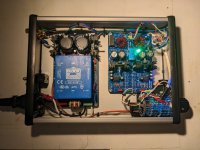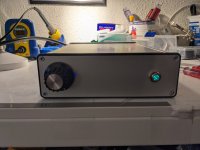I like the write up on grounding, in power amplifiers I always used a ground lift scheme but in a low power application like headphone amps it did seem to be overkill. I like to make my cases compact and this will help, if I was more motivated I would learn to 3d print cases and that would add another layer of safety with a non conductive case.
Bill
BTW Omicron is relatively insensitive to RF ingress (no exposed high impedance points, relatively low input impedance, inputs and outputs protected by RF filters), so you might be able to get away with some other approach, e.g. floating the amp inside a grounded chassis. I have not tested this and am not sure if that's code compliant.
I love the grounding write up too. Originally my Omicron was floating in a grounded chassis, after reading alex's write up, I ended up putting in a tiny little loop breaker consisting of a 10R NTC and 22nF film cap, then tying the PSU 0v to the loop breaker, seems to work as expected so far. Loop breaker is a tiny board, 31.5mm x 18mm, it has 2 mounting holes spaced 24.5mm apart (lines up with vent holes on modushop Galaxy chassis), one of the mounting holes is the earth connection, the other isolated. I am debating coming up with a board that has a diode bridge as well, but it would need to be very compact, not sure on what an ideal diode bridge would be for that.
Thank you for the write up on different ways to ground the headphone amp.
I just tried to test the power supply only with a 125ma fuse and a dim bulb. While the led on the power supply lit up briefly the fuse blew immediately. Should I try a higher rated fuse? I'm using an iec inlet with a built in fuse holder.
I just tried to test the power supply only with a 125ma fuse and a dim bulb. While the led on the power supply lit up briefly the fuse blew immediately. Should I try a higher rated fuse? I'm using an iec inlet with a built in fuse holder.
The dim bulb tester works pretty good for high loads, probably depends on your wattage bulb. My variac has an amp meter and voltmeter I watch when powering up the first time. There is always a surge on initial power up as you charge the capacitors to be aware of and sometimes a slow blow fuse is needed.First power up is always a little nerve racking.
Bill
Bill
Thanks for the advice. Unfortunately my variac doesn't have an amp meter or a voltmeter. I'm a bit of a novice at this unfortunately. I tried hooking up the amp board to the power supply board. The LED comes on in the power supply but not on the through hole board. I'll have to try to play around with it a bit more.
In addition to what @bloqhed kindly pointed out, Mouser suggests a replacement part of which they have 100 in stock. And yes, ordering parts on a tablet is hard. The "mobile" web site of Mouser is plaily unusable unless you have the exact P/N.the pulse transformer has 0 stock
Just put normal wire into a PVC tube. That's double insulation if you ask me.source double insulated wire
These are easy to substitute with e.g. Omron G5V or G6A, CUI SR10 or SR11, etc.reliable source for K1, RY-24W-K
I finished up the project this morning, really sounds excellent. I haven't had enough time to comment on the sound quality yet but very transparent and I'm just using a 3.5mm to RCA from my phone.
A bit challenging for a beginner like me but I'm very happy with the result.
A bit challenging for a beginner like me but I'm very happy with the result.
Really very happy with this headphone amp. I listened to it for about an hour with a pair of hifiman HE500's as well as my Beyerdynamic t1gen 2. Sounds fantastic. I only wish I was better at drilling haha.
Attachments
Thanks Bill, I've built a couple amps before and I have a fair amount of experience soldering but I don't understand a lot of the more technical aspects. I'll look into a optical center punch.
I've been listening to this Omicron amp all afternoon and the sound really is fantastic. Absolutely no background noise and is completely silent without a source playing at full volume. It's a huge step up from the headphone amp I was using before, a bottlehead crack with the speedball upgrade.
The soundstage is really amazing with my hifiman cans and there's a wonderful amount of detail. Very liquid sounding and the amp just seems to do everything right. The amp runs very cold too, the case never even gets warm.
I've been listening to this Omicron amp all afternoon and the sound really is fantastic. Absolutely no background noise and is completely silent without a source playing at full volume. It's a huge step up from the headphone amp I was using before, a bottlehead crack with the speedball upgrade.
The soundstage is really amazing with my hifiman cans and there's a wonderful amount of detail. Very liquid sounding and the amp just seems to do everything right. The amp runs very cold too, the case never even gets warm.
I made a crossfeed switch board for the through hole version Omicron!
This board includes a crossfeed switch and a high pass filter to boost treble a little.(experimental)
I'm not sure my board doesn't ruin the performance of the omicron but it's works fine for me.
I have attached the gerber file. If you are interested, Feel free to use it to order PCBs.
FYI, The red circles in the first and second pictures are where you need to connect to the mainboard.
Thank you for sharing this superb project!
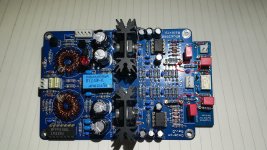
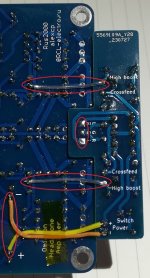
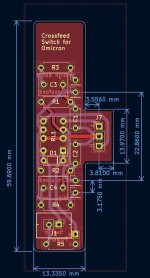
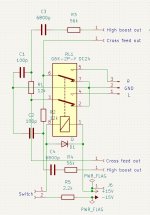
This board includes a crossfeed switch and a high pass filter to boost treble a little.(experimental)
I'm not sure my board doesn't ruin the performance of the omicron but it's works fine for me.
I have attached the gerber file. If you are interested, Feel free to use it to order PCBs.
FYI, The red circles in the first and second pictures are where you need to connect to the mainboard.
Thank you for sharing this superb project!




Attachments
so I was thinking of stacking the amp board on top of the power supply board to take up less space on my bedside table, I recall you stating that the block transformers tend to radiate emf above and below them and I think you recommended using a toroid transformer, how do the r cores perform in comparison?
Thanks
Bill
Thanks
Bill
Interference when using a UI trafo like the BLOCK FL was sometimes an issue in an early prototype, before I switched from cylindrical to toroidal coils for the output filter. Toroidal output coils eliminated interference, and there should be no similar problem with the SMT board that uses a trifilar transformer.
I have not tested it with R-core power trafos. With toroids like the Talema/AMVECO/etc. 70054 or 70064 (both fit the power supply board) there was no issue. I guess R-core wouldn't create much interference either, as the leakage flux on a properly wound R-core should be minimal.
I have not tested it with R-core power trafos. With toroids like the Talema/AMVECO/etc. 70054 or 70064 (both fit the power supply board) there was no issue. I guess R-core wouldn't create much interference either, as the leakage flux on a properly wound R-core should be minimal.
Hello, Alex says its designed for >32ohm. So it will not suitable for Hifiman HE 400SE, 25ohm, 91db sensitivity?
Thanks in advance
Thanks in advance
I think it will work just fine. The limitation of the output stage is mostly in the maximum current it can deliver while still behaving nicely, but 25ohm is not that low. For best results, you'd probably want the through hole version with a higher quiescent current (and hence taller heatsinks), but the difference would be minimal if audible at all. You may also want to increase C9 C10 C29 C30 from 47uF to 100uF or 150uF at 6.3V or 10V.
- Home
- Amplifiers
- Headphone Systems
- Omicron, a compact headphone amp with -140dB distortion
